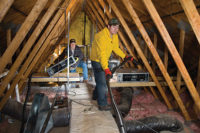School Opts For An HVAC Makeover
"The school's 20-year-old HVAC system used water chillers for cooling and a boiler for heating, and it presented many climate and maintenance problems," said Ruse Smith, owner and operator of Smith Air Conditioning.
"The building needed heating in the morning and cooling in the afternoon. Temperature changeovers took a long time, and individual classrooms did not have individual control. When teachers opened doors to cool classrooms, humidity trickled in and ceilings turned brown with mold."
The 20,600-square-foot school accommodates 282 students and 25 faculty members.
Maintenance bills for the old system totaled nearly $30,000 the previous year. Something had to be done to eliminate comfort problems and escalating costs.
Smith analyzed possible solutions for the school. Gas furnaces instead of heat pumps could be used, but the classrooms were not equipped with gas piping. The cost of operation was the same for heat pumps and furnaces, but it would cost more to cut holes in the roof of each classroom and put gas packs on to equip the classrooms with gas furnaces, Smith reasoned.
The decision was made to use heat pumps in the classrooms and Lennox' L Series® rooftop units that utilized existing ductwork and gas piping in the gym, stage, and foyer areas.
On the rooftop, five 10-ton L Series gas packaged units were installed over the gym and stage areas. A 5-ton L Series unit was used in the foyer. In the smaller classrooms, eight 12-SEER split heat pumps were used. All units were configured to fit the existing ductwork. Each classroom has an electronic thermostat to help regulate temperature, and thermostats controlling the stage, gym, and foyer have remote sensors installed in the principal's office.
A Tight Schedule
The retrofit job was completed over the school's four-month summer vacation. However, certain parts of the school, such as the gym, were still used during the summer and needed air conditioning."Because the school needed air conditioning during the summer break, we had to complete the job in parts," said Smith.
Another problem was posed by the limited space in the ceiling. Normally, the heat pump is in-stalled, and the condensation runs off the coil into a condensate container. Due to limited space, a low-profile condensate pump had to be used, which needed a bigger condensate container.
"If the electricity was all shut off at one time, there was a possibility the low-profile condensate container would not be big enough to hold all the condensation," said Smith.
To prevent overflowing, the low-profile condensate pump was placed in an auxiliary pan.
The school reports that its annual energy bill was cut from $84,930 to $67,932. Sacred Heart was so impressed with Smith's job, they asked him to join the board planning committee for the school.
"The school had great confidence in me, since the job had great results," said Smith.
"This was also a good job for possible future clients. They can see the cost-saving results of a major HVAC renovation firsthand, and it helps convince them to get an HVAC makeover."
Publication date: 08/16/2004





